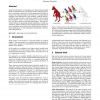Free Online Productivity Tools
i2Speak
i2Symbol
i2OCR
iTex2Img
iWeb2Print
iWeb2Shot
i2Type
iPdf2Split
iPdf2Merge
i2Bopomofo
i2Arabic
i2Style
i2Image
i2PDF
iLatex2Rtf
Sci2ools
TOG
2008
2008
Randomized cuts for 3D mesh analysis
The goal of this paper is to investigate a new shape analysis method based on randomized cuts of 3D surface meshes. The general strategy is to generate a random set of mesh segmentations and then to measure how often each edge of the mesh lies on a segmentation boundary in the randomized set. The resulting "partition function" defined on edges provides a continuous measure of where natural part boundaries occur in a mesh, and the set of "most consistent cuts" provides a stable list of global shape features. The paper describes methods for generating random distributions of mesh segmentations, studies sensitivity of the resulting partition functions to noise, tessellation, pose, and intra-class shape variations, and investigates applications in mesh visualization, segmentation, deformation, and registration.
Related Content
| Added | 15 Dec 2010 |
| Updated | 15 Dec 2010 |
| Type | Journal |
| Year | 2008 |
| Where | TOG |
| Authors | Aleksey Golovinskiy, Thomas A. Funkhouser |
Comments (0)

